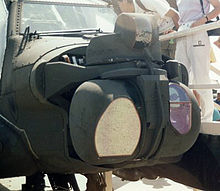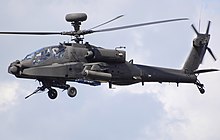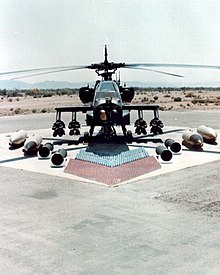Boeing AH-64
| Boeing AH-64 Apache | |
|---|---|
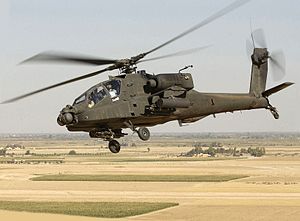 AH-64D "Apache Longbow" in Iraq , without a radome over the rotor mast |
|
| Type: | Heavy attack helicopter |
| Design country: | |
| Manufacturer: |
|
| First flight: |
September 30, 1975 |
| Commissioning: |
April 1986 |
| Production time: |
In series production since 1982 |
| Number of pieces: |
> 2500 (as of July 2020) |
The AH-64 Apache [ əpætʃi ] is a heavy, twin-engine attack helicopter ( English attack helicopter , AH), which mainly from the United States Army is used. The Apache was developed by the US company Hughes Aircraft and is now produced by Boeing .
history
In the Vietnam War , helicopters were used on a large scale for the first time. Apart from the Bell AH-1G "Cobra" , the models used were mainly developed for transport and reconnaissance tasks and not for combat missions and were insufficiently armed and protected. The US lost almost 5,000 helicopters in a war in which enemy units only occasionally appeared as large and as dense as they would in conventional battles. Highly stressed components corroded in the prevailing high humidity and temperature of the application area in the area of the alternately humid tropics .
A development contract for a heavy attack helicopter had already been put out to tender by the US Army in 1964 . The result was the Lockheed AH-56 "Cheyenne", a high-speed dive attack helicopter. This concept became obsolete when it turned out in practice that this tactic made the helicopter extremely vulnerable to surface-to-air missiles fired at its dive angle . Since the whole design of the Cheyenne was influenced by the fall attack, the AH-56 project was discontinued.
For the second attempt, the US Army also wanted better maneuverability, night operational capabilities and excellent low-level flight capabilities. The new helicopter was designed for use in wooded, hilly and mountainous areas of Europe and Asia. The Hughes YAH-64 prototype was able to impressively demonstrate its capabilities in its test flights from September 30, 1975. After a thorough test phase, the helicopter went into series production in March 1982 with an initial unit price of around 17 million US dollars. On January 26, 1984, the first AH-64A were delivered to the US Army. The 6th Cavalry Regiment was the first unit to report full operational capability with the AH-64A in July 1986. Up to July 1993, 800, up to October 1995 a total of 900 and up to the year 2000 then 1048 AH-64 Apache were built and delivered in different versions. The A series was operated until 2012; At the same time, the use of the E series began.
commitment
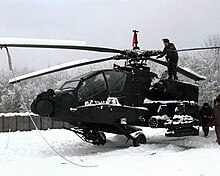
The Apache attack helicopter had its first combat mission in 1989 during the US invasion of Panama . The AH-64 later played essential roles in the Second Gulf War , Operation Enduring Freedom in Afghanistan, and the Iraq War .
The use of the AH-64A Apache in Operation Desert Storm (1990/91) was mostly directed against Iraqi main battle tanks and other armored vehicles and proved to be very effective because the Iraqi air defense tactics were not prepared for this. In the first wave of attacks, the attack helicopters were also used against parts of the Iraqi radar network in order to enable the bombers to penetrate the enemy airspace unnoticed. However, the US Army had significant problems with the maintenance and repair of the AH-64. The fine desert dust clogged the air conditioning filters in the cockpit and had a long-term negative effect on the pilots' operational capability. The wear and tear on the turbines and other moving parts also increased and required additional logistics capacities. Eight helicopters were hit by enemy air defenses throughout the war. One of the helicopters hit was shot down, with the crew surviving the crash. With the help of the Apache itself, more than 500 battle tanks, 120 transport tanks , 30 air defense systems, 50 bunkers and 10 helicopters were destroyed. On February 17, 1991, an American AH-64 accidentally destroyed a US armored personnel carrier of the Bradley type and an M113 armored personnel carrier with Hellfire missiles , killing two US soldiers and wounding six.
In the Third Gulf War (2003) the AH-64D Apache Longbow were used in the invasion of Iraq. During the advance on Baghdad, a large number of these combat helicopters were used between Karbala and Kut. 33 combat helicopters of the 11th Aviation Regiment - otherwise stationed in Illesheim - attacked the Iraqi 2nd Panzer Division of the Republican Guard near Karbala on March 24, 2003 . The US attack failed because the Iraqi reconnaissance pursued the orderly approach and covered the attack helicopters with concentrated defensive fire from the ground. 30 helicopters were hit but were able to return to base. An AH-64D, however, had to make an emergency landing and the crew became a prisoner of war. Another AH-64D was destroyed during the night landing on a desert airfield. After this incident, the AH-64D were no longer deployed in the depths of enemy territory; instead, the helicopter has since been deployed on the front line. Despite various improvements since 1991, the engines also proved to be unsuitable for the desert; for example, the AH-64D were often unable to take off due to the blowing up of desert dust during take-off.
The reports of vulnerability to ground attacks, especially in urban areas, increased. So ground troops or lone fighters repeatedly managed to hit parts of the drive or control of the helicopter and force the machines to make an emergency landing or even to crash them. On January 28 and February 2, 2007, ground fires in Taji and Najaf resulted in the loss of one AH-64D and its crew.
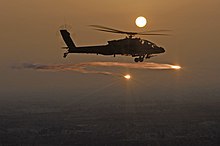
Studies have shown that 80 percent of all Apache deployed in Afghanistan returned from deployment with bullet holes in sometimes critical locations that were actually considered protected. This is also due to the design as an anti-tank weapon or "tank destroyer", which makes it less suitable for the environment of asymmetrical warfare . Unlike the Sikorsky UH-60 transport helicopter , for example, the AH-64 is not intended for landings in hostile areas and is therefore not fully armored. Seven Apache were used as part of Operation Anaconda , all of which were hit by machine guns and RPG bazookas . Although there was no crash, five of them had to be extensively repaired.
Another problem arose when an Apache crashed and made another emergency landing: Parts of the cover of the Hellfire missile had got into the tail rotor , so the order was temporarily issued to only fire missiles from the right pylon because the suction effect was less there (see also : "The Hellfire Disaster" ).
Basically, the Apache continues to be one of the most effective combat helicopter weapon systems. After the end of the RAH-66 Comanche stealth helicopter project , which was supposed to represent an expansion of the capabilities, a successor is not planned and the AH-64 will remain in service for a long time.
technology
Cockpit and armor
The Apache is a two-seater helicopter in which the crew is arranged one behind the other: the gunner sits in front and the pilot 48 cm higher directly behind. The cockpit has front and side windows made of bulletproof glass and is equipped with armor plates, which are made of chemical boron compounds for reinforcement , all around and between the two pilots, the pilots' seats are also reinforced with kevlar and thus offer additional protection downwards and backwards, as well as restricted laterally. According to the specification, the armor can withstand hits from 12.7 mm ammunition. There are no ejection seats available to pilots in the event of a crash .
The helicopter cell is armored and many components of the helicopter are redundant. The armor consists of a several centimeter thick foam , which is mixed with a special PET compound and connected to a few layers of Kevlar by a fire-retardant synthetic resin . According to the specification, the helicopter can continue to fly for at least 30 minutes after being hit by 12.7 mm ammunition from below and can hit 23 mm ammunition, as used in the widely used ZSU-23-4 anti-aircraft tank, in some non-flight-critical areas Cope with components. For this purpose, among other things, critical parts of the power transmission were reinforced with steel sleeves. The armored glass used is 4.5 cm thick and also withstands hits from 23 mm projectiles. If the window frame is warped after a crash landing, the pilots can also blow off the windows. Lines, pipes and cables are also laid as far as possible in the fuselage in order to reduce the chances of simultaneous damage. For the same reason, the engines were attached to the fuselage as far apart as possible. The Apache has a non-retractable, sprung main landing gear. Due to their construction, the landing gear and airframe offer the crew a mathematical chance of survival of 95 percent in the case of landings with a sink rate of up to 12.8 m / s, which corresponds to an impact speed on the ground of approx. 46 km / h.
Engines
Two T700-GE-701 engines from General Electric , each with 1238 kW (1660 PS), bring the helicopter to a top speed of 293 km / h horizontally (without external loads or mast sights on the AH-64D Longbow), the maximum permissible speed ( Never -exceed-speed , VNE) is 365 km / h. With a mast sight, the AH-64D Longbow reaches a top speed of 265 km / h horizontally. In emergencies, both engines can be overloaded with up to 1447 kW (1940 hp) for around two minutes. If one of the engines catches fire, all ventilation flaps are automatically closed in order to smother the fire. The Apache has crash-proof internal fuel tanks with a capacity of 1421 liters, which give it a range of up to 482 kilometers with a 30-minute reserve. They are self-sealing and remain tight even after being hit by 30 mm ammunition. In addition, with external tanks, the fuel capacity can be increased to 4910 liters and thus the range for transfers to up to 1899 km with a 45-minute reserve. The engine outlets are equipped with a special system to reduce the infrared signature. By adding cold air and a better turbulence, the detection range of hostile IR systems should be reduced.
Rotors
The left-hand main rotor is an articulated rotor, the blades of which are connected horizontally and vertically with flapping and swivel joints. The main rotor blades each consist of five stainless steel spars in a glass fiber bed and are coated with several layers of stainless steel. The number of layers increases towards the leaf root. The rear edge of the rotor blades is made of composite materials. The tail rotor consists of two two-blade rotors, which are arranged one above the other on the tail rotor shaft at an angle of 55 ° to reduce noise. The main gearbox can work for up to an hour without oil, as can the tail rotor gearbox.
Radar and target acquisition
The core of the offensive capabilities of the Apache AH-64A is the TADS-FCR (Target Acquisition and Designation System-Fire Control Radar) AN / ASQ-170 . It can locate targets optically in both the visible and the infrared spectrum and aim at them with a laser. The laser is used to target the main weapon, the Hellfire - anti-tank guided weapon . In addition, the helicopter can mark targets for other units, for example the US Air Force , which they can then fight with laser-guided weapons ( “buddy lasing” ). In addition, the PNVS (Pilot Night Vision Sensor) AN / AAQ-11 is installed in the chin tower above the TADS , which works in the infrared range and transmits its images to the cockpit screens or the helmet visors of the crew. The AH-64D Longbow installed on the rotor mast is AN / APG-78 - millimeter - fire control radar to that can detect and in less than a minute up to 128 targets classify. It has a range of up to 8 km. From 2005 the TADS / PNVS sensors were replaced by the Arrowhead system from Lockheed Martin, which provides a greater range and higher resolution.
The target acquisition takes place via a visor system IHADSS ( Integrated Helmet And Display Sight System ) connected to the pilots' helmet . A head movement of the pilot in the direction of the target to be captured swivels the target acquisition laser in the corresponding direction. At the same time, information about the target, together with information about the flight status of the helicopter, is displayed in the vision system.
In the AH-64D version, the TADS-FCR serves as a fall-back level if the Westinghouse millimeter-wave radar mounted on the rotor mast of this version should fail.
transport
The Apache can be transported by air, among other things. If air loading is necessary, the helicopter's rotor blades can be folded or dismantled, and the legs of the main landing gear can also be folded back to save height. If these measures are exhausted, two Apache helicopters can be loaded into Lockheed C-141 and Airbus A400M transport aircraft, up to three in McDonnell Douglas C-17 A aircraft and up to six in the larger Lockheed C-5 .
Users
-
 Egypt
Egypt
- Egyptian Air Force : 45 , 36 AH-64A, 45 AH-64D (35 converted AH-64A, 10 newbuildings), 43 AH-64E (conversion of AH-64D planned)
-
 Greece
Greece
- Greek Army : 32 , 20 AH-64A +, 12 AH-64D
-
 India
India
- Indian Air Force : 22 AH-64E (I) (ordered September 2015, shipped 2019/2020)
- Indian Army : 6 AH-64E (I) (ordered in February 2020, delivery after the arrival at the IAF)
-
 Indonesia
Indonesia
- Land Forces : 8 AH-64E (delivery since 2017)
-
 Iraq
Iraq
- Iraqi Air Force : 6 AH-64 (leasing planned since 2014 to start flight training), 24 AH-64E (procurement planned since 2014) [obsolete]
-
 Israel
Israel
- Israeli Air Force : 87 , 42 AH-64A "Peten" (18 newbuildings delivered from September 12, 1990, 24 more used ones taken over by the US Army, 24 still active), 21 AH-64D "Saraph" (delivered from 2005, still 20 active), AH-64E planned, a total of two squadrons at Ramon Air Base
-
 Japan
Japan
- Ground Self-Defense Forces : 13 AH-64DJP (since 2006)
-
 Qatar
Qatar
- Qatar Emiri Air Force : 24 AH-64E (ordered 2016, delivery 2019/2020)
-
 Kuwait
Kuwait
- Air Force : 16 AH-64D (ordered in 2005)
-
 Morocco
Morocco
- Royal Moroccan Air Force : 24 AH-64E delivery requested
-
 Netherlands
Netherlands
- Koninklijke Luchtmacht : 30 AH-64D Block 1, converted into AH-64D Block 2 from 2009, 28 converted into AH-64E from 2018
-
 Saudi Arabia
Saudi Arabia
- Royal Saudi Land Forces : 48 , 12 AH-64A (since April 1993), 36 AH-64E (appointed in 2013)
- Saudi Air National Guard : 36 AH-64E (planned, 12 of which ordered in 2013)
-
 Singapore
Singapore
- RSAF : 20 AH-64D
-
 South Korea
South Korea
- South Korean Army : 36 AH-64E (ordered in spring 2013, delivery from 2016) [obsolete]
-
 Taiwan (Taiwan)
Taiwan (Taiwan) - Army of the Republic of China : 30 AH-64E (delivery 2013/2014)
-
 United Arab Emirates
United Arab Emirates
- Air Force : 30 AH-64A (delivered from October 30, 1993, conversion to AH-64D)
-
 United Kingdom
United Kingdom
- British Army : 67 , 67 WAH-64 ("Apache" AH.1), conversion of 50 units to the AH-64E standard (ordered in 2016/19)
-
 United States
United States
- United States Army : 727 , 107 AH-64A, 620 AH-64D (as of January 2011)
Station locations in Germany
The Apaches stationed in Germany belonged without exception to the United States Army .
- Hanau Army Airfield , 1989 to 2005, AH-64A / D (initially 2-227th and 3-227th , from 1997 1–501st Aviation Regiment ), conversion to AH-64D 1997
- Illesheim Army Airfield , since 1987, AH-64A / D (initially 2-6th and 6-6th Cavalry Regiment , from 2005 2-159th and 3-159th Aviation Regiment ), conversion to AH-64D 2003, since 2016 only on a rotation basis , 2017 also AH-64E for the first time
- Coleman Barracks (Mannheim), AH-64A / D, only one maintenance unit, the 2-502nd Aviation Regiment , is to move to the Storck Barracks in Illesheim
In Europe there are further bases in Greece ( Megara and Stefanovikio), the Netherlands ( Gilze-Rijen ) and the United Kingdom ( Middle Wallop and Wattisham )
Versions

- AH-64A
- The basic version of the US Army and for export.
- AH-64B
- After the Apache was first used in the Gulf War in 1991, 250 Apache should be converted to version B with improved systems such as GPS , SINCGARS , target transfer capacity (different Apache can exchange their found targets with each other) and new rotor blades. However, the program was canceled in 1992 after a few prototypes.
- AH-64C
- The Apache C should be a modernization of the machines up to the standard of version D, but the old engines should remain in the machines and no radar should be installed.
- AH-64D
- The "Apache Longbow" was introduced in 1998. Originally only the machines equipped with Westinghouse radar were called “Longbow”, but then it was decided to drop the Apache C program and to equip all machines with new engines and to modernize them generally. Therefore, every Apache used in war zones today is a Longbow Apache, but these are available with and without radar. The standard deployment tactics provide that one of two helicopters operating together is equipped with radar. From the beginning of 2003, the helicopters delivered complied with the Block II standard, which contained digitized avionics equipment in the cockpit. The Longbow Apache can fire the new Hellfire II missile , which is equipped with its own millimeter-wave radar seeker. This gives the Apache real "fire and forget" capabilities, because the helicopter only has to emerge briefly from the terrain cover, fire a rocket and then fly back into cover. With the laser-guided Hellfire, however, the laser must be switched on all the time; alternatively, in “LOAL” mode (lock-on after launch), the shooter can first fire a rocket from cover, but then has to emerge in time for the laser to mark the target and the rocket to change course.
- AH-64E
- The AH-64E "Apache Guardian" is the new name since October 2012 for the variant previously known as AH-64D Block III. The US Army stated that the new name "Apache Guardian" was necessary due to the performance increases due to the new upgrades. The extensions to the AH-64E include improved digital connectivity, the installation of the new Joint Tactical Radio System, more powerful T700-GE-701D turbines, an improved transmission for a maximum of 2120 kW, the ability to control UAVs, full IFR capabilities and 15 cm longer composite rotor blades. The new rotor blades, which successfully completed the flight test in May 2004, increase the speed, rate of climb and payload capacity of the Apache. Another innovative capability is MUM-T (Manned-Unmanned Teaming), which enables US pilots to take control of nearby drones at any time and thus gain access to their sensors, live camera streams and weapons. With the MUM-T, the operating range of the Apache is significantly increased. The pilots can use the drones to scout out their targets at a distance of 80 to 100 kilometers long before they approach the target area and can easily keep an eye on them even when moving. The system is already being used successfully in Afghanistan. In October 2010, Boeing received the order for series production of the new Apache; delivery began in November 2011. The first unit is expected to be ready for use a year later. The US Army is planning a total of 690 AH-64E, with 56 new machines being produced and 634 Apaches to be converted. First, 236 Block I helicopters are to be brought up to this level.
- WAH-64 / AH Mk.1
- This version of Apache was specially developed for the British Army . Major parts of the equipment were not manufactured by Boeing , but by Agusta-Westland in Great Britain. Lessons were also learned from past mishaps. The WAH-64 has new communication and radar systems. Other differences to the AH-64D are the installation of a de-icing system for the rotors, more powerful engines (Rolls-Royce RTM322) and the possibility of using Brimstone and CRV7 missiles. In order to be able to use the WAH-64 from aircraft and helicopter carriers, it is equipped with foldable rotor blades. The first Apache landing on a ship took place in June 2004 on board the British helicopter carrier HMS Ocean . In late 2005, Great Britain became the first country to regularly use the Apache at sea. The Ministry of Defense is considering long-term procurement of additional Apaches specifically for the Royal Navy. On November 14th, 2008 the British Army received their first two Apache AH.1 equipped with the new M-TADS vision and target acquisition system.
costs
The cost of a new AH-64D Apache Longbow 1996 amounted to 18 million US dollars (USD), retrofitting the Longbow radar costs about $ 4 million. The development of the four Longbow prototypes was commissioned for $ 194.6 million; the complete construction lot of 807 helicopters cost 1.17 billion USD (as of 1991). In 2013, the list price was between $ 52 million and $ 61 million.
The twelve Apache that Egypt bought, including weapons and spare parts, cost $ 318 million; Kuwait's contract is valued at $ 800 million, including weapons, spare parts and maintenance services.
Technical specifications
| Parameter | AH-64A Apache | AH-64D Apache Longbow |
|---|---|---|
| crew | 2 (pilot and gunner) | |
| overall length | 17.76 m | |
| Hull length | 14.97 m | |
| Length over main rotor | 17.39 m | |
| Length over tail rotor | 15.47 m | |
| Rotor diameter | 14.63 m | |
| Tail rotor diameter | 2.79 m | |
| Wingspan | 5.82 m | |
| height | 4.30 m | 4.95 m |
| Empty mass | 5,165 kg | 5,352 kg |
| normal takeoff mass | 6,552 kg | 7,480 kg |
| Max. Takeoff mass | 9,525 kg | 10,423 kg |
| Top speed | 293 km / h | 265 km / h |
| Rate of climb | 12.7 m / s | 7.5 m / s |
| Service ceiling | 6,400 m | 5,915 m |
| Operational range | 482 km (with normal takeoff mass) | 407 km (with normal takeoff mass) |
| Engines | 2 × General Electric T700-GE-701 turbines (up to 1,696 hp) |
2 × General Electric T700-GE-701C turbines (up to 1,940 hp) |
Armament
The Apache is armed with a 30 mm on-board cannon of the type M230 , which is mounted pivotably under the front fuselage . On the two stub wings to the left and right of the fuselage there are a total of four attachment points for air-to-ground weapons and two attachment points for air-to-air weapons. The wing stations are usually equipped in pairs with four AGM-114 Hellfire anti -tank guided weapons at the outstations and one container each with nineteen unguided 70 mm Hydra rockets at the inner stations. Fully equipped with 16 Hellfire or four containers with Hydra missiles is also possible. AGM-65 Maverick air-to-surface missiles can also be fitted (1 per attachment point). In newer versions of the Apache there is a station for two air-to-air missiles of the Stinger type or a Sidewinder in the extension of the stub wings .
Pivoting installed armament in a mount under the front fuselage
- 1 × 30-mm automatic cannon M230 with 1,200 rounds of ammunition (max only cannon -. With additional missile armament 750 rounds) HEDP (High Explosive Dual Purpose, M789), HEI (High Explosive Incendiary, M799) in a magazine box
Armament up to 1500 kg at six external load stations under the two stub wings
Air-to-air guided missiles
- 2 × guided missile launchers for 2 × Raytheon AIM-92 "Stinger" - infrared-controlled short-range air-to-air missiles (only AH-64D)
- 2 × Raytheon AIM-9L "Sidewinder" - infrared controlled short-range air-to-air guided missiles (only AH-64D)
Air-to-ground guided missiles
- 4 × M299 launcher racks each with 4 × Boeing Corp / Martin Marietta AGM-114 "Hellfire" - laser-controlled anti-tank guided weapons
Unguided air-to-surface missiles
- 4 × LAU-5003 / CRV7 rocket launchers for 19 × unguided Hydra air-to-surface missiles each ; Caliber 70 mm / 2.75 inch (only WAH.64)
- 4 × LAU-261 rocket launchers for 19 × unguided Hydra air-to-surface missiles each; Caliber 70 mm / 2.75 inch
- 4 × LAU-68/69 rocket launchers for 7 × unguided Hydra air-to-surface missiles each; Caliber 70 mm / 2.75 inch
External container
- 4 × additional disposable fuel tanks with 870 liters (230 US gallons) of kerosene each
Self protection
In the area of self-protection, the following sensors are used for self-defense: Sensors AH-64A
- 4 × AN / APR-39 ( radar warning device for AH-64A)
- 1 × AN / ALQ-162 (radar jamming system for AH-64A)
- 1 × AN / ALQ-136 (V) 5 (radar jamming system)
AH-64D sensors
- 1 × AN / APR-48 (radar localization with interferometry for AH-64A / D)
- 4 × AN / ALQ-211 (V) 1 (radar warning and jamming system for AH-64D, replaces AN / APR-39)
- 4 × AN / AVR-2 - (laser warning device)
- 2 × AN / ALQ-212 (comprising the AN / AAR-57 - missile alert system and an optional Infrarotstörsystem)
The following avionic components are used in the area of self-protection:
- 1 × BAE AN / ALQ-144 (V) 3 "disco light" - infrared guided missile interference system (infra-red guided missile countermeasure devices, IRCM)
- 2 × Tracor M130 decoys with 30 decoys (36 mm wide such as M-1 or M-206 heat flares)
- 4 × BAE AN / ALE-47 flare launchers with 30 flares (36 mm wide such as CCU-136A / A heat flares)
literature
- Attack helicopter. Technology, armament, types. Karl Müller Verlag, Erlangen, ISBN 3-86070-690-X .
- TM 1-1520-251-10 Technical Manual for Helicopter, Attack, AH-64D Longbow Apache. US Army.
- Chris Bishop: Apache AH-64 Boeing (McDonnell Douglas) 1976-2005. Osprey Publishing, 2005, ISBN 1-84176-816-2 .
- David Donald: AH-64A / D Apache and AH-64D Longbow Apache. In: Modern Battlefield Warplanes. AIRtime Publishing Inc, 2004, ISBN 1-880588-76-5 .
Web links
- FAS AH-64 Apache
- Archive about AH-64 accidents and the like - Shots
- Staff Study: Advanced Attack Helicopter , US Government Accounting Office, Washington, DC, 1974. (PDF file; 1.1 MB)
Individual evidence
- ↑ Haynes, Mary L. and Cheryl Morai Young, ed. "Department of the Army Historical Summary, FY 1987, Chapter 5: Modernizing and Equipping the Army . " Center of Military History, United States Army, 1995.
- ^ Karl Schwarz: Production for over 30 years: Boeing delivers 2500th Apache. July 1, 2020, accessed July 1, 2020 .
- ↑ a b c d e f g h AH-64 Fact Sheet ( February 25, 2008 memento in the Internet Archive ), Jane's Air Force News, October 13, 2000
- ↑ a b Jane’s Modern Military Helicopter. 1998, p. 114.
- ↑ Chop the Chopper , Fred Kaplan
- ↑ a b c d e [Statement from factory employees. TV documentary, N24 - The Helicopter Factory. Aired February 7, 2010]
- ↑ Detailed images of the rotor heads of the AH-64
- ↑ FliegerRevue, November 2010, pp. 26–29, New Arrowhead for Apache
- ↑ Egypt to upgrade Apaches to AH-64E standard , Janes, May 11, 2020
- ↑ Boeing finishes deliveries of AH-64E and CH-47F to Indian air force , Flightglobal, July 10, 2020
- ↑ US signs deals with India for MH-60R, Apache helicopters , Janes, February 25, 2020
- ^ First AH-64E Apache Guardian for Indonesia arrives from US , Defense News, December 18, 2017
- ↑ Qatar signs deal for 24 AH-64E Apaches , Flightglobal, June 8, 2016
- ↑ Morocco requests Apache helos , Janes, August 1, 2019
- ↑ Netherlands upgrades Apaches, Janes, September 17, 2018
- ^ Jen Judson: Saudi Arabian National Guard helicopter force takes shape. In: defensenews.com. February 23, 2017, accessed February 27, 2017 .
- ↑ FlightGlobal: Taiwan receives first batch of AH-64E Apaches. Retrieved November 6, 2013 .
- ↑ UK now has all 50 AH-64E Apaches under contract , Janes, March 10, 2020
- ^ World Military Aircraft Inventory. 2011 Aerospace. Aviation Week and Space Technology, January 2011.
- ↑ AUSA: US Army to re-designate Block III Apache as AH-64E. Flightglobal, October 24, 2012, accessed October 27, 2012 .
- ↑ THE WORLD: attack helicopters in use - The Apache Guardian: . In: THE WORLD . December 14, 2017 ( welt.de [accessed April 2, 2018]).
- ^ Army gets faster, more capable Apache aircraft. Globalsecurity.org, November 7, 2011, accessed October 27, 2012 .
- ↑ AH 64D Apache Longbow
- ↑ Jane's Air Force News: Boeing AH-64 Apache ( Memento from February 25, 2008 in the Internet Archive )
- ↑ AH-64 Specifications. In: GlobalSecurity.org , October 13, 2000.

